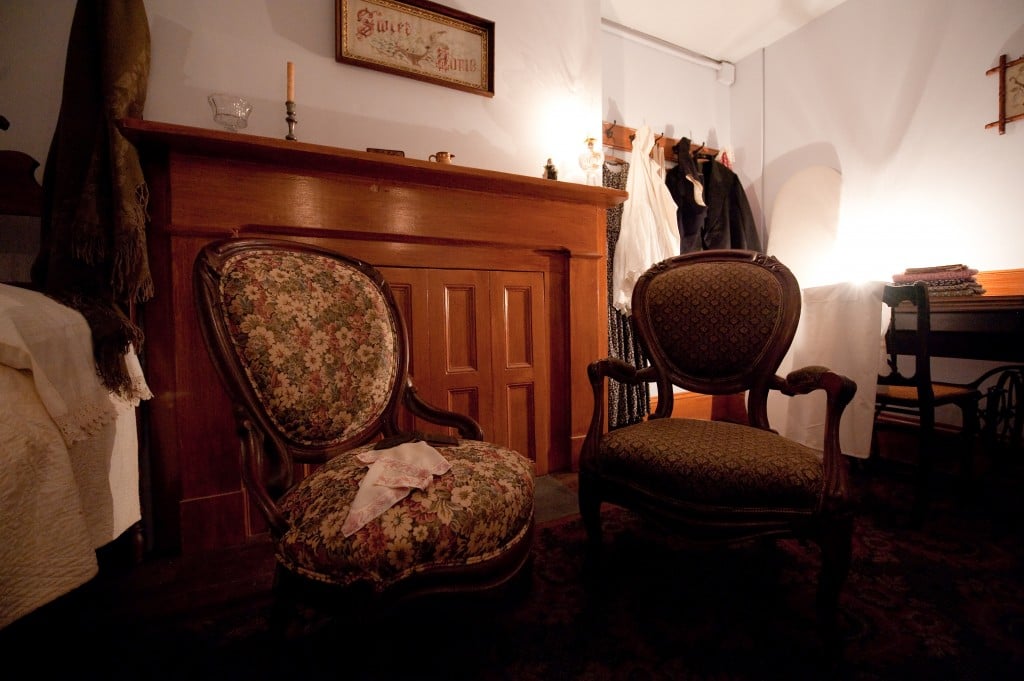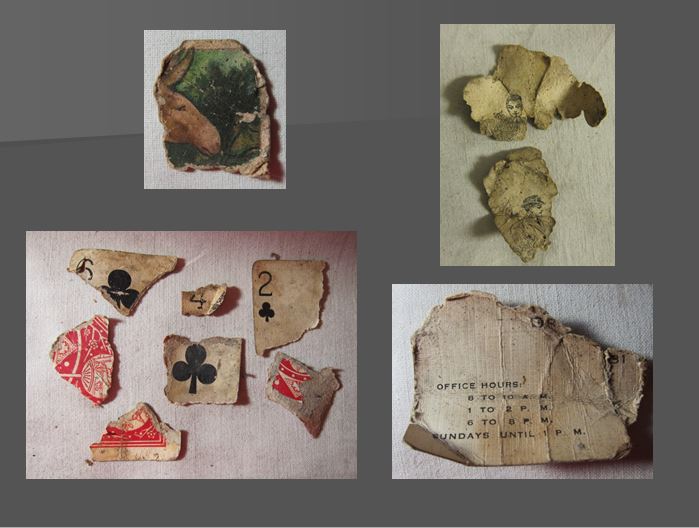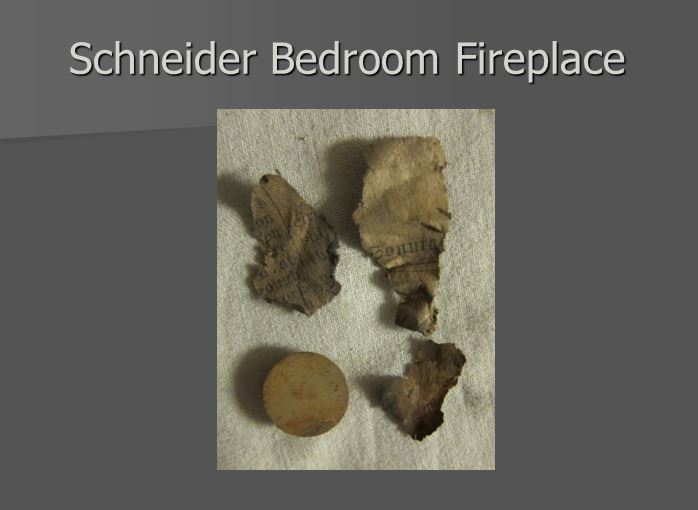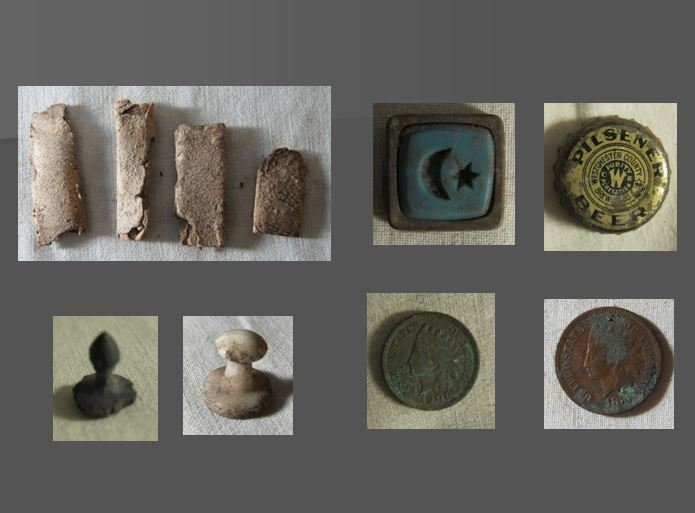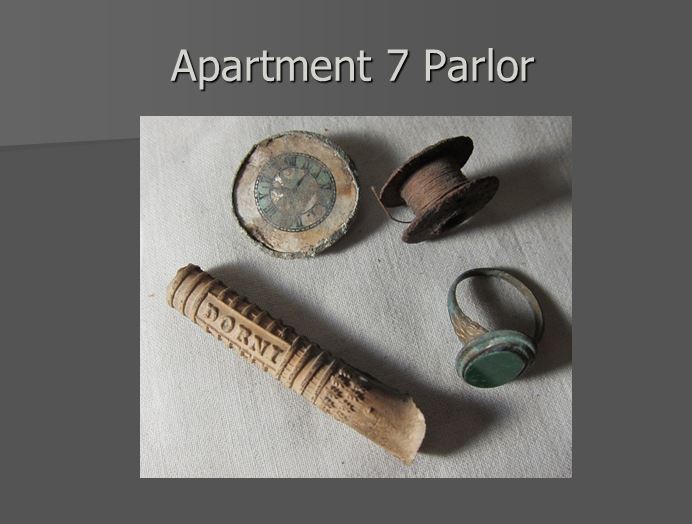Blog Archive
Peach Pits and Mouse Mummies: An Interview with a Collections Intern
Most New York City interns spend their summers running for coffee or filing paperwork, but at the Tenement Museum interns have the opportunity to gain hands-on experience not only in museum work, but also in the very history of the building. As the summer intern in our Collections Department, Julia Czech helped uncover the past of 97 Orchard Street- literally – and was able to engage with the tenement building in a very real and tangible way. She was kind enough to tell us about her summer at 97 Orchard.
What did you do as the summer collections intern?
I spent the majority of my summer sorting through several large garbage bags filled with dust, soot, plaster and a number of fascinating artifacts from residents of 97 Orchard Street.
Last January, conservators worked on stabilizing the ceilings in several ruin apartments. To do so, they removed the floorboards above the ceilings and cleared out the debris underneath them so that they could secure the plaster and plasterboard throughout 97 Orchard Street. The debris they removed from beneath the floorboards was carefully bagged and saved for staff to sort through at a later point. Six months later, the ceilings in the ruin apartments looked great, but the bags remained unsorted!
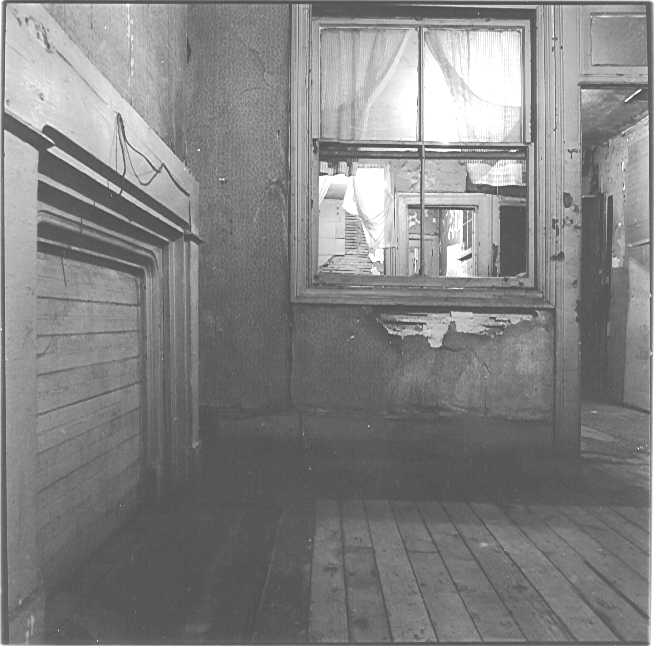
One of the 'ruin' apartments in 97 Orchard Street. We call the apartments that remain in their dilapidated states 'ruin' apartments, even though they still hold many treasures.
My job this summer was to carefully sort through each bag, remove the artifacts or remnants of human life, accession them into the museum’s collections and then catalog them so that they would be clearly labeled and sorted for future researchers.
Where were the bags from within 97 Orchard?
The bags were from four separate spaces within the Tenement Museum: Apartment Seven’s kitchen, Apartment Seven’s parlor (Apartment Seven is a ruin apartment on the third floor of the building), the Schneider kitchen fireplace, and the Schneider bedroom fireplace.
Which room had the most artifacts?
Apartment Seven’s kitchen had the most artifacts by far. Of the 47 bags I sifted through, 18 were from this space and I found over 1,000 artifacts within these bags.
What did you find most frequently when sorting?
Over 50% of the items I found were animal bones – likely remnants from meals – and most of these bones were large with butcher cut marks on them. I also found a lot of paper fragments (about 12% of the objects), as well as seeds, fruit pits, eggshells, onion skins and orange skins (about 11%).
How did the objects in each room differ?
Apartment Seven’s kitchen had so many artifacts that it would sometimes take an entire morning to sort through one bag from it. The objects I found in these bags were often large and distinguishable, and showed a lot of life in the space. Items like pennies, hair pins, buttons and sewing needles showed that people were using the space for a variety of purposes, while the bones, seeds and pits indicated the consumption and preparation of food in the space.
On the other hand, the Schneider bedroom fireplace was almost devoid of artifacts, and what I did find in there was so singed that it was often nothing more than ash. It seemed pretty clear that whereas the kitchen fireplace was used for cooking and had a lot of life going on around it, the bedroom fireplace was more exclusively for warmth and was not as active of a location.
Another interesting difference was in the paper fragments. Most of the paper fragments I found in Apartment Seven were written in English or Yiddish, whereas the paper fragments I found in the Schneider debris were mostly English and German.
What was the coolest object you found?
Overall, I thought the paper fragments were fascinating because they gave real glimpses into what was going on at the time these people lived in 97 Orchard. Some of the fragments had ads for jobs or suit sales, some were business cards or labels from bottles, and others had really neat images. One of my favorite paper fragments showed a colorful donkey in a jungle.
I also found two pennies in Apartment Seven’s kitchen- one from 1876 and one from 1906- cigarette butts, game pieces, and a bottle cap from the Westchester County Brewing Company.
In Apartment Seven’s parlor I found what I think I would have to say are my two favorite items: a ladies ring with a green stone, and a pipe stem that reads ‘Peter Dorni.’ I love how personal these items are and how much they can tell us about the time period and environment of that apartment.
What was the most surprising thing you found?
Not everything about what I was doing was glamorous, and as one might expect in a tenement building, I found a lot of evidence of mice and rats. We joke that rats were the first curators because when they build their nests, they pull in all sorts of items like paper and fabric. In doing so, they collect and preserve a lot of interesting artifacts like the ones I was able to uncover this summer.
However, it also means that they were very present under the floorboards and I uncovered probably 15 mouse carcasses while sorting through the bags. Interestingly, they were all mummified and well preserved. Although it’s a bit startling to reach into a bag and find a mummified mouse when you’re expecting to find a bone fragment, the mummification of their carcasses says something very interesting about the preservation conditions under the floorboards!
Thanks for all the hard work this summer, Julia!
If you would like to apply for a summer internship at the Tenement Museum, click here and click the “Summer Internships at the Lower East Side” tab.
– Posted by Kathleen O’Hara and Julia Czech
